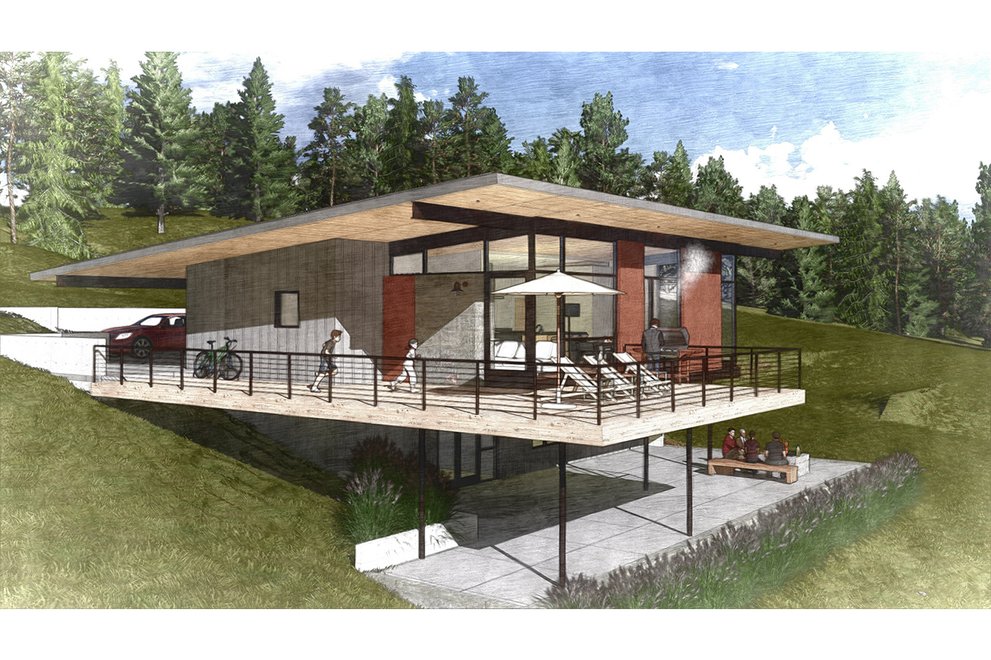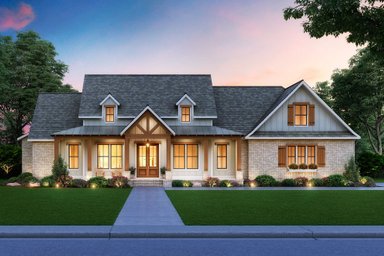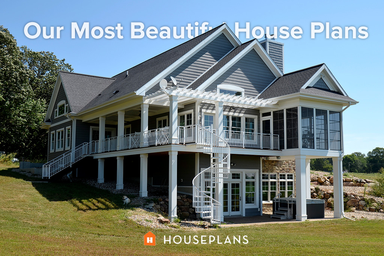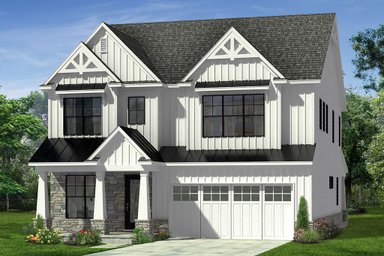{NOTE: Katherine's description of this famous house is insightful and an excellent introduction to Modernism and International Style. I would only add that when I myself visited the house, there was a fascinating exhibit of letters from the owners to Le Corbusier asking him to please do something about all the leaks -- I think they ended up suing him. Modern architecture has a back story! DG}
Villa Savoye: Still Provocative After All These Years
Among architects, the Villa Savoye is one of the most famous houses in the world. Though not familiar to the average American, everyone who ever sat through lectures on Modernism, including this columnist, knows this icon like the back of her hand.
Designed by the Swiss-born Le Corbusier in 1928, the house is in the Paris suburb of Poissy. Last month, I finally saw it, and it was a revelation. As a student I had studied the floor plans and photographs endlessly, but there's no substitute for seeing the real thing.
What makes this house so special? It is provocative.
The Villa Savoye, best described as a box on stilts, is utterly unlike any house I have ever seen. Its unusual plan and circulation flow force a visitor to rethink the very idea of "house." For example, should a house have an obvious front and back? In this case, all four sides are the same.
Though the Villa Savoye never became a trendsetter, some features are definitely part of the architectural mainstream. Indeed, the basic elements in many new houses today — large windows that fill a space with light, big multipurpose rooms, open floor plans with only a few strategically placed walls and sliding glass doors with large areas of glass that make adjacent decks or patios appear to be part of the room — can be traced back to this house.
The last of a series of villas that Le Corbusier designed during the 1920s, the Villa Savoye embodied many of his theories that had turned the architecture world of that time on its ear. As painters and sculptors were turning from representational art to complete abstraction (from, say, recognizable landscapes to canvases with greens, browns and blues that hinted at vegetation), avant-garde architects, led by Le Corbusier, were designing buildings that were pared down to their essences. Rooms became "volumes that were defined by light." Both exteriors and interiors were stark and spare. Abandoning the elaborate ornamentation that had characterized Western architecture since the beginning of the Renaissance, Le Corbusier sheathed his exteriors with plain white stucco.
Le Corbusier declared that not only should houses for the industrialized era look different, they should also be built differently, taking advantage of all that the new technologies had to offer. To lower costs, he favored mass production of components such as windows and doors in factories over building-site fabrication by individual craftsmen.
For housing, he favored a structural framework made of reinforced concrete instead of the traditional masonry and wood, a switch that also opened up new design possibilities. Roofs could be flat, and both roofs and floors could be supported by concrete beams and columns instead of walls. Thus "liberated," the walls could be placed anywhere that function or whimsy dictated. No longer structural, the exterior walls functioned merely as "curtains" of enclosure. Windows could be as big and extensive as the designer wanted.
At the same time Le Corbusier was formulating theories and exploring new materials, he was also confronting lifestyle changes that still bedevil architects today. When you approach your house in a car, where do you put the entry and where do you stow the car? His solution at Villa Savoye is ingenious, though possible only with a wealthy client.
In effect, Le Corbusier designed the house to fit the car, in this case a chauffeur-driven limousine. At ground level, the structure's footprint is a U-shaped driveway — the exact turning radius of a 1929 Voisin — overlaid with a column grid. Wedged between the legs of the U is the "service area," which included two maids' rooms, a chauffeur's apartment, and a three-car garage. The owners' living quarters are on the second floor, which is raised on "pilotis" — Le Corbusier's term for supporting columns.To reach the front door, the owners' chauffeur drove under the house. As he began to turn, following the driveway, the solid wall of the service core gave way to the curved glass wall of the entry foyer, which echoes the movement of the car (a neat trick). The chauffeur stopped at the front door (which is actually at the back of the house), where the owners alighted and entered their light-filled lobby. The driver, continuing around the curve, either pulled into the garage or drove straight ahead and exited.Inside the house, the prosaic has been turned into art.
The huge light-filled lobby (about 630 square feet) is dominated by a circular "scissor-stair." A fairly common type of staircase — it has a landing halfway up so that in profile the staircase looks like an open pair of scissors — has been transformed into a sinuous, twisting white sculpture that continues upward through the house. Beckoning straight ahead is an alternate route to the living quarters above, a light-filled ramp.Like most visitors, I suspect, I took the ramp. It leads to a second, smaller lobby, and a stunning view of a large interior courtyard, Le Corbusier's "hanging garden." The biggest surprise is the living/dining room. Even by modern standards it is huge: about 910 square feet, measuring 19 feet 6 inches by 46 feet with a 12-foot ceiling. The wall overlooking the terrace is made of two huge pieces of glass, each so big that the wall seems to disappear and the inside and outside merge. (Each glass pane is about 14 feet wide and 10 feet high; one is actually a sliding glass door.) In contrast, the other two exterior living room walls have a long horizontal band of windows that frame the views of surrounding meadows. All the other rooms on the second floor also have these horizontal windows and views.
The ramp, now outside, continues upward toward the roof and a semi-enclosed "solarium," intended for sunbathing.The house also has touches of whimsy here and there. For example, the master bathroom includes a sunken tub and a built-in, curved tiled seat that looks like sculpture, but is actually functional. It can be used for resting after taking a bath.Would anyone build a house like the Villa Savoye today? While the approach, the entry and the light-filled journey from one floor to another — either by ramp or by stair — are extraordinary, I think most people would opt to spend most of their budget on spaces they will be occupying, not those they will use only when going from one room to another. And most people would not want 12-foot ceilings in every room to "experience the volume."
When I imagined living there, I found the bloom began to come off the rose in other ways as well. The living room is spectacular, but it lacks intimacy. It's hard to feel cozy, or to have an intimate conversation or a small, friendly dinner party in a space that's big enough to be the lobby in a medium-sized office building. The central terrace is wonderful, but it is incorporated into only one living area. The master suite, which is across the terrace from the living room, could also have had a wall of glass and a similar merging of the indoors and outdoors instead of only one relatively small window.
The most important take-away lesson for someone planning a new house, however, is right in line with Le Corbusier's original intentions. A visit to a house that is really different from your own aesthetic inclinations and experience will shake up your thinking. In the process, you may get some ideas that would never have come to you otherwise.
Villa Savoye: Still Provocative After All These Years
Among architects, the Villa Savoye is one of the most famous houses in the world. Though not familiar to the average American, everyone who ever sat through lectures on Modernism, including this columnist, knows this icon like the back of her hand.
Designed by the Swiss-born Le Corbusier in 1928, the house is in the Paris suburb of Poissy. Last month, I finally saw it, and it was a revelation. As a student I had studied the floor plans and photographs endlessly, but there's no substitute for seeing the real thing.
What makes this house so special? It is provocative.
The Villa Savoye, best described as a box on stilts, is utterly unlike any house I have ever seen. Its unusual plan and circulation flow force a visitor to rethink the very idea of "house." For example, should a house have an obvious front and back? In this case, all four sides are the same.
Though the Villa Savoye never became a trendsetter, some features are definitely part of the architectural mainstream. Indeed, the basic elements in many new houses today — large windows that fill a space with light, big multipurpose rooms, open floor plans with only a few strategically placed walls and sliding glass doors with large areas of glass that make adjacent decks or patios appear to be part of the room — can be traced back to this house.
The last of a series of villas that Le Corbusier designed during the 1920s, the Villa Savoye embodied many of his theories that had turned the architecture world of that time on its ear. As painters and sculptors were turning from representational art to complete abstraction (from, say, recognizable landscapes to canvases with greens, browns and blues that hinted at vegetation), avant-garde architects, led by Le Corbusier, were designing buildings that were pared down to their essences. Rooms became "volumes that were defined by light." Both exteriors and interiors were stark and spare. Abandoning the elaborate ornamentation that had characterized Western architecture since the beginning of the Renaissance, Le Corbusier sheathed his exteriors with plain white stucco.
Le Corbusier declared that not only should houses for the industrialized era look different, they should also be built differently, taking advantage of all that the new technologies had to offer. To lower costs, he favored mass production of components such as windows and doors in factories over building-site fabrication by individual craftsmen.
For housing, he favored a structural framework made of reinforced concrete instead of the traditional masonry and wood, a switch that also opened up new design possibilities. Roofs could be flat, and both roofs and floors could be supported by concrete beams and columns instead of walls. Thus "liberated," the walls could be placed anywhere that function or whimsy dictated. No longer structural, the exterior walls functioned merely as "curtains" of enclosure. Windows could be as big and extensive as the designer wanted.
At the same time Le Corbusier was formulating theories and exploring new materials, he was also confronting lifestyle changes that still bedevil architects today. When you approach your house in a car, where do you put the entry and where do you stow the car? His solution at Villa Savoye is ingenious, though possible only with a wealthy client.
In effect, Le Corbusier designed the house to fit the car, in this case a chauffeur-driven limousine. At ground level, the structure's footprint is a U-shaped driveway — the exact turning radius of a 1929 Voisin — overlaid with a column grid. Wedged between the legs of the U is the "service area," which included two maids' rooms, a chauffeur's apartment, and a three-car garage. The owners' living quarters are on the second floor, which is raised on "pilotis" — Le Corbusier's term for supporting columns.To reach the front door, the owners' chauffeur drove under the house. As he began to turn, following the driveway, the solid wall of the service core gave way to the curved glass wall of the entry foyer, which echoes the movement of the car (a neat trick). The chauffeur stopped at the front door (which is actually at the back of the house), where the owners alighted and entered their light-filled lobby. The driver, continuing around the curve, either pulled into the garage or drove straight ahead and exited.Inside the house, the prosaic has been turned into art.
The huge light-filled lobby (about 630 square feet) is dominated by a circular "scissor-stair." A fairly common type of staircase — it has a landing halfway up so that in profile the staircase looks like an open pair of scissors — has been transformed into a sinuous, twisting white sculpture that continues upward through the house. Beckoning straight ahead is an alternate route to the living quarters above, a light-filled ramp.Like most visitors, I suspect, I took the ramp. It leads to a second, smaller lobby, and a stunning view of a large interior courtyard, Le Corbusier's "hanging garden." The biggest surprise is the living/dining room. Even by modern standards it is huge: about 910 square feet, measuring 19 feet 6 inches by 46 feet with a 12-foot ceiling. The wall overlooking the terrace is made of two huge pieces of glass, each so big that the wall seems to disappear and the inside and outside merge. (Each glass pane is about 14 feet wide and 10 feet high; one is actually a sliding glass door.) In contrast, the other two exterior living room walls have a long horizontal band of windows that frame the views of surrounding meadows. All the other rooms on the second floor also have these horizontal windows and views.
The ramp, now outside, continues upward toward the roof and a semi-enclosed "solarium," intended for sunbathing.The house also has touches of whimsy here and there. For example, the master bathroom includes a sunken tub and a built-in, curved tiled seat that looks like sculpture, but is actually functional. It can be used for resting after taking a bath.Would anyone build a house like the Villa Savoye today? While the approach, the entry and the light-filled journey from one floor to another — either by ramp or by stair — are extraordinary, I think most people would opt to spend most of their budget on spaces they will be occupying, not those they will use only when going from one room to another. And most people would not want 12-foot ceilings in every room to "experience the volume."
When I imagined living there, I found the bloom began to come off the rose in other ways as well. The living room is spectacular, but it lacks intimacy. It's hard to feel cozy, or to have an intimate conversation or a small, friendly dinner party in a space that's big enough to be the lobby in a medium-sized office building. The central terrace is wonderful, but it is incorporated into only one living area. The master suite, which is across the terrace from the living room, could also have had a wall of glass and a similar merging of the indoors and outdoors instead of only one relatively small window.
The most important take-away lesson for someone planning a new house, however, is right in line with Le Corbusier's original intentions. A visit to a house that is really different from your own aesthetic inclinations and experience will shake up your thinking. In the process, you may get some ideas that would never have come to you otherwise.






